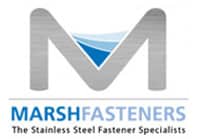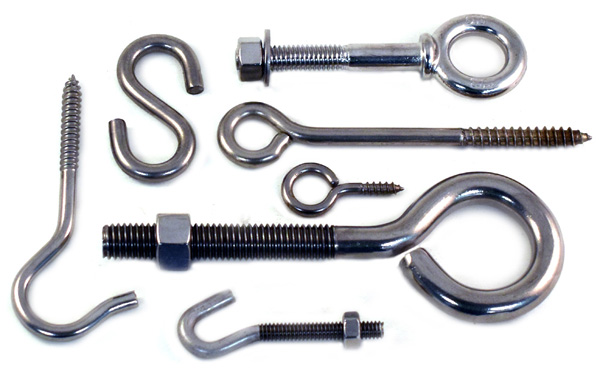We at Marsh Fasteners are proud to provide a large selection of premium stainless steel eye bolts and hooks, to meet your project requirements. We'll review the several kinds of stainless steel eye bolts and hooks available, along with tips for using them securely and efficiently.
Types of Stainless Steel Eye Bolts and Hooks
You have a few options for stainless steel eye bolts and hooks, each made for a particular use. Here is a quick summary of the available various kinds:
- Regular (Plain) Pattern Nut Eye Bolt: A nut is tightened from the shaft end to secure these eye bolts to their load. For applications where access is convenient from both directions, they are perfect.
- Shoulder Pattern Nut Eye Bolt: The shoulder located beneath the loop on these eye bolts improves the ability to distribute the load evenly evenly. They are appropriate for several uses, such as hoisting.
- Machinery Eye Bolt: Usually featuring completely threaded shanks attached to threaded or tapped holes, machinery eye bolts are used to raise points on equipment. Stainless steel is one of the materials they are made of.
- Bent-Formed Eye Bolt: This adaptable eye bolt can be fastened to a cable assembly using its threaded or eye end.
- Lag Eye Bolt: Lag eye bolts are perfect for applications involving wood since their threads are made to screw into wood. Nevertheless, the kind and quality of the wood affects how much weight it can support.
- Screw Eye Bolt: Frequently utilized in lighter applications, screw eye bolts attach to buildings with ease thanks to their tapered bolt shank.
- Military Spec MS51937: These machinery eye bolts are appropriate for various military uses and are approved for use by all Department of Defense departments and agencies.
- Lifting Eyes: These drop-forged, heat-treated eyes in threaded or blank forms are ideal for heavy lifting applications.
- Eye Bolts with Rings Secured: These eye bolts are not meant for lifting applications and have welded rings.
Considerations for Choosing the Right Eye Bolt
Choosing the appropriate eye bolt for your project is essential to guaranteeing both effectiveness and safety. Here are some important things to think about:
- Working Load Limit (WLL): The eye bolt's maximum safe weight limit is indicated by the WLL. It changes according to the eye bolt's dimensions and composition.
- Material: Select an eye bolt compatible with the material it will be attached to and robust enough to handle the weight. Eye bolts of stainless steel resist corrosion and work well in various settings.
- Type of Attachment: Verify that your equipment or material can accommodate the eye bolt type you have chosen to be firmly fastened.
- Load Angle: Remember that an eye bolt's working load limit reduces as the load angle moves away from vertical. For angle loading, utilize shoulder eye bolts at all times.
- Safety Precautions: Do not overload or shock load eye bolts; instead, use the appropriate instruments, such as a wrench, to tighten nuts.
How to Safely Use Eye Bolts
It's essential to use eye bolts properly to avoid mishaps and extend the life of your tools. The following safety advice is provided:
- To prevent bending, align the eye bolt with the slings.
- Place washers between the shoulder and the load surface for a snug fit.
- While utilizing shims or washers, engage at least 90% of the threads.
- One sling leg should be fastened to each eye bolt.
- Examine and clean the hole and the threads of the eye bolt.
- Screw the eye bolt down to ensure proper seating.
- Make sure there is enough depth in the tapped hole for a screw eye bolt.
- Use regular eye bolts for a spreader bar that maintains a 90° lift angle.
- A horizontal angle of more than 45° should be avoided as it dramatically lowers lifting capacity.
Things Not to Do With Eye Bolts
When utilizing eye bolts, steer clear of the following to guarantee safety and compliance:
- Decreasing the angle of lift by passing a sling through two eye bolts.
- Putting eye bolts through slings to change the weight and angle.
- Utilizing machined, stamped, or ground eye bolts.
- Tightening eye bolts with bars, grips, or wrenches.
- Applying paint to eye bolts since it can conceal defects.
- Forcing hooks or other fittings—which need to fit freely—into the eye.
- Fasteners for shock-loading eyes.
- For loads that can spin freely, use a single eye bolt.
- Using eye bolts that have defects, such as worn threads.
- Use a shackle instead of an eye bolt when a hook's tip is inserted.
Marsh Fasteners provides an extensive assortment of stainless steel eye bolts and hooks for various sectors and uses. Choosing the appropriate eye bolt and utilizing it correctly are crucial for a safe and effective procedure. Our premium stainless steel fasteners are engineered to provide outstanding performance and durability, regardless of the application for which you require eye bolts, be it aerospace, marine engineering, chemical, or any other profession.
Please don't hesitate to contact us if you need help choosing the appropriate eye bolts for your project or have any questions. We are here to meet your needs by offering you superior stainless steel eye bolts and knowledgeable advice.


Leave a comment
You must be logged in to post a comment.